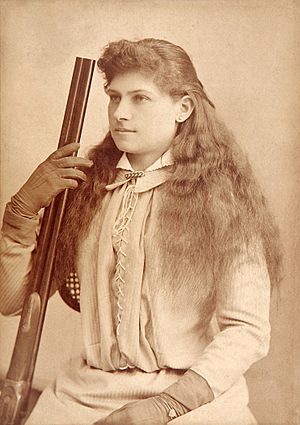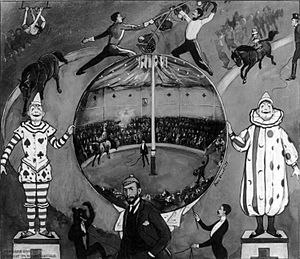Annie Oakley facts for kids
Quick facts for kids
Annie Oakley
|
|
|---|---|

Oakley in the 1880s
|
|
| Born |
Phoebe Ann Moses
August 13, 1860 Darke County, Ohio, U.S.
|
| Died | November 3, 1926 (aged 66) Greenville, Ohio, U.S.
|
| Resting place | Ashes buried in Brock Cemetery |
| Spouse(s) |
Frank E. Butler
(m. 1876) |
| Signature | |
Annie Oakley (born Phoebe Ann Moses; August 13, 1860 – November 3, 1926) was an amazing American sharpshooter. She became a huge star in Buffalo Bill's Wild West show, showing off her incredible shooting skills.
Annie learned to hunt as a child to help her family, who were very poor. When she was just 15, she won a shooting contest against an experienced shooter named Frank E. Butler. She later married him in 1876.
In 1885, Annie and Frank joined Buffalo Bill's famous show. They traveled all over Europe, performing for kings, queens, and other important leaders. Audiences were amazed! Annie could shoot a cigar right out of her husband's hand. She could even split a playing card on its edge from 30 paces away. She earned more money than anyone else in the show, except for Buffalo Bill himself.
After a serious train accident in 1901, Annie had to slow down. She then toured in a play about her life. She also taught many women how to shoot, because she believed women should be able to defend themselves. Her performances were even filmed for one of Thomas Edison's first movies in 1894! After she passed away, her story became famous in musicals and movies, like Annie Get Your Gun.
Contents
Annie's Early Life
Annie Oakley was born Phoebe Ann Mosey on August 13, 1860. She grew up in a log cabin in Darke County, Ohio. Her parents, Susan and Jacob Mosey, were Quakers. They moved to a farm in Ohio around 1855.
Annie was the sixth of her parents' nine children. Her father passed away when she was only five years old. This left her family very poor. Because of this, Annie couldn't go to school regularly when she was young.
When she was nine, Annie had to live with another family to help care for their baby. They promised to pay her and give her an education, but they didn't keep their promise. Annie called them "the wolves" because they treated her so badly. She even ran away from them after about two years.
Annie started trapping animals before she was seven. By age eight, she was shooting and hunting to help feed her family. She sold the animals she hunted to local shops, who then sent them to hotels in bigger cities. Her amazing hunting skills helped her family pay off the mortgage on their farm by the time she was 15.
How Annie Met Frank
Annie became very well known for her shooting skills. On Thanksgiving Day in 1875, a traveling shooter named Frank E. Butler was performing in Cincinnati, Ohio. Frank, who was an Irish immigrant, made a bet that he could beat any local shooter.
The hotel owner set up a shooting match between Frank and 15-year-old Annie. Frank was surprised to see such a young girl as his opponent! Annie won the match, and Frank lost his bet. Soon after, Frank started spending time with Annie, and they fell in love. They got married and never had children.
Historians aren't completely sure about the exact date of their wedding. Some records say it was in 1876, while others suggest it was in 1882 in Canada. It's possible the later date was used to make Annie seem younger to the public, as she often changed her age for her performances.
Annie's Amazing Career
Annie and Frank Butler lived in Cincinnati for a while. Annie chose "Oakley" as her stage name. Some people think she picked it from the Oakley neighborhood in Cincinnati where they lived.
In 1885, they joined Buffalo Bill's Wild West show. Annie was only five feet tall, so another performer, Sitting Bull, gave her the nickname "Watanya Cicilla," which means "Little Sure Shot." This nickname stuck with her throughout her career.
During her first time with Buffalo Bill's show, Annie had a friendly competition with another sharpshooter named Lillian Smith. Lillian was 11 years younger than Annie. Annie left the show for a short time but returned two years later, just in time for a big show in Paris in 1889. This three-year tour made Annie America's first female star. She earned more money than anyone else in the show, except Buffalo Bill himself.
In Europe, Annie performed for many important people, including Queen Victoria of the United Kingdom and the German Kaiser Wilhelm II. It's said that the Kaiser even asked Annie to shoot the ashes off a cigarette he was holding!
From 1892 to 1904, Annie and Frank lived in Nutley, New Jersey.
Annie believed that women should be involved in the military. In 1898, she wrote a letter to President William McKinley. She offered to create a group of 50 "lady sharpshooters" who would bring their own weapons if the U.S. went to war with Spain. The Spanish–American War did happen, but Annie's offer was not accepted. However, Theodore Roosevelt named his volunteer cavalry the "Rough Riders" after Buffalo Bill's show, where Annie was a big star.
In 1901, Annie was seriously hurt in a train accident. She had to have five operations on her spine. She recovered and left Buffalo Bill's show. In 1902, she started a new acting career in a play called The Western Girl, which was written just for her. In the play, Annie played Nancy Berry, a character who used a pistol, rifle, and rope to outsmart bad guys.
Throughout her life, Annie taught more than 15,000 women how to use a gun. She strongly believed it was important for women to learn how to shoot, not just for exercise, but also for self-defense. She once said, "I would like to see every woman know how to handle guns, as naturally as they know how to handle babies."
Annie in Early Movies
Buffalo Bill was friends with Thomas Edison, the famous inventor. Edison even built a huge power plant for the Wild West Show.
In 1894, Annie and Frank performed in one of Edison's early movies, called "Little Sure Shot of the Wild West". This short film showed Annie shooting at targets. It was filmed on November 1, 1894, and lasted about 21 seconds. It was one of the very first movies ever shown to the public!
Annie and Sitting Bull
Annie Oakley and the famous Native American leader Sitting Bull became friends while working together in Buffalo Bill's show. Sitting Bull was very impressed with Annie's shooting skills. He thought she must have a special gift to shoot so accurately with both hands.
In 1884, Sitting Bull symbolically "adopted" Annie as his daughter. He gave her the name "Little Sure Shot," which she used for the rest of her career. They had great respect for each other.
Later Years and Legacy
In 1913, Annie and Frank built a home in Cambridge, Maryland. This house, known as the Annie Oakley House, is now a historic landmark. In 1917, they moved to North Carolina.
Annie continued to set shooting records even into her sixties. She also gave a lot of money to charities, especially those helping young women. In 1922, at age 62, she hit 100 clay targets in a row from 16 yards away in a shooting contest!
In late 1922, Annie was in a car accident that forced her to wear a steel brace on her right leg. She recovered after more than a year and even performed again in 1924, setting more records.
Annie's health got worse in 1925. She passed away from a blood disease in Greenville, Ohio, on November 3, 1926, at age 66. She was cremated, and her ashes were buried in Brock Cemetery. Sadly, Frank Butler was so heartbroken that he stopped eating and died just 18 days later. He was buried next to her.
After her death, it was discovered that Annie had spent all her money helping her family and giving to charities.
Today, you can see many of Annie Oakley's personal items, performance souvenirs, and firearms at the Garst Museum and the National Annie Oakley Center in Greenville, Ohio. She has been honored in many places, including the Trapshooting Hall of Fame and the National Cowgirl Museum and Hall of Fame.
Annie's Family Name
Annie Oakley's family name, Mosey, has been spelled in different ways. Many people thought it was "Moses." However, her family's official records and her father's headstone show the name as "Mosey." The Annie Oakley Foundation, run by her relatives, uses "Mosey" as the correct spelling.
Annie herself sometimes insisted her name be spelled "Mozee." It's thought she might have preferred this spelling because it sounded more like how it was pronounced.
"Annie Oakleys"
During Annie's lifetime, complimentary tickets to shows became known as "Annie Oakleys." This is because these tickets often had holes punched in them to prevent them from being resold. These holes reminded people of the playing cards Annie would shoot holes through during her amazing sharpshooting acts!
Annie in Books, Movies, and TV
Annie Oakley's life has inspired many stories and performances:
- The movie Annie Oakley (1935) starred Barbara Stanwyck.
- The famous Irving Berlin Broadway musical Annie Get Your Gun (1946) is based loosely on her life. It starred Ethel Merman.
- The movie version of the musical (1950) starred Betty Hutton.
- Gail Davis played a made-up version of Annie Oakley in the TV series Annie Oakley (1954 to 1956).
- Geraldine Chaplin played Annie in the movie Buffalo Bill and the Indians, or Sitting Bull's History Lesson (1976).
- Jamie Lee Curtis played Annie in Tall Tales & Legends (1985).
- Reba McEntire played Annie in Buffalo Girls (1996) and later in a Broadway revival of Annie Get Your Gun.
- Elizabeth Berridge played Annie in the movie Hidalgo (2004).
- Annie Oakley has also appeared in comic books and other stories.
Annie's Impact
Annie Oakley became a worldwide star and earned more money than most other performers in Buffalo Bill's show. Even with her success, she never forgot where she came from. She and Frank often gave money to charities that helped orphans.
Annie was a huge inspiration for women. She encouraged women to learn how to use guns, not just for fun, but to feel strong and independent. She showed everyone that women could be just as capable as men if they were given the chance. Her image helped create the idea of the American cowgirl, showing that women could be brave and skilled.
See Also
 In Spanish: Annie Oakley para niños
In Spanish: Annie Oakley para niños







